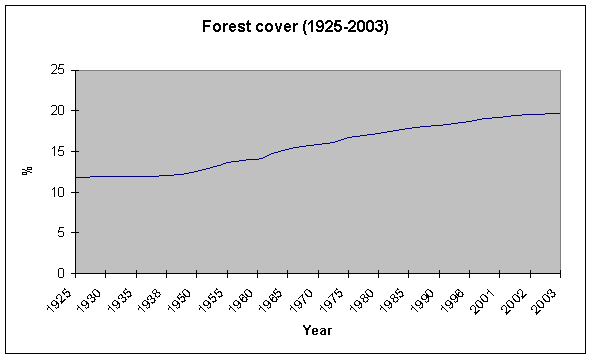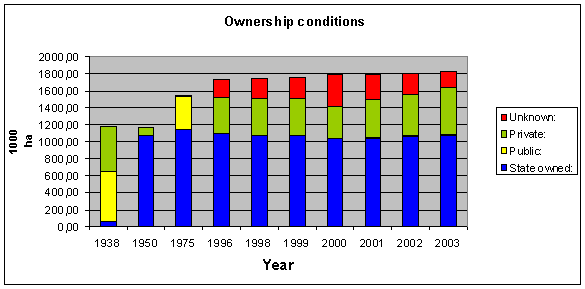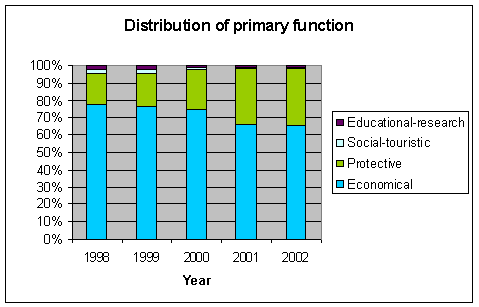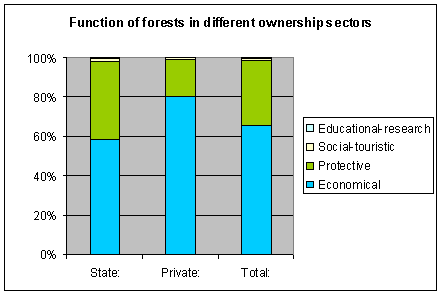


Prepared by Tamás Gábor ALI
State Forest Service
Forest Administration Unit,
Budapest 1054 Széchenyi u. 14
HungaryTel: +36 1 3014384
Fax: +36 1 3014678e-mail: [email protected]
The total area of Hungary is 93030 km2. Forests are the second largest cultivation type after arable land.
Areas subject to forest management total to 1,93 million ha (2002), while the stocked area totals to 1,80 million ha (19.4%).
The forest area per 1000 capita is 177 ha. The regional distribution of forests is unequal. The percentage of forest cover in the plain region is 9,4%, while it is 27% in the mountainous and hilly regions.
Unlike to the general situation in Europe, 86% of forests are broadleaved forests. The most valuable tree species are beech and oak, while black locust and poplar occupy significant areas as well. 57% of forest areas is occupied by indigenous tree species, while 43% is occupied by introduced tree species (black locust, red oak, conifers) or cloned species (improved poplars). The distribution of tree species is as follows: oak 21,0%, Turkey oak 11,5%, beech 6,1%, black locust (introduced 300 years ago) 21,8%, hornbeam 5,7%, improved poplar 6,6%, indigenous poplar 3,2%, other broadleaved 10,3%, conifers 13.9%.
The total forest area in Hungary is managed according to management plans that are prepared for ten years. Forest management is supervised by the State Forestry Service (SFS) operating all round the country in regional directorates.
The current ownership structure of forest areas is as follows:
- State-owned 58 %,
- Community-owned 1 %,
- Privately owned 41 %.
The majority of the state-owned forests is managed by the 19 state Forest holding companies, and by the 3 forestry shareholding companies owned by the Ministry of Defence.
Individual and co-operative management is pursued in some parts of privately owned forests, the management status of an ever-decreasing portion is still unresolved, mostly due to shared joint ownership, therefore on those areas, no adequate forest management has begun yet. The about 795 thousand hectares of privately owned forests are extremely fragmented from an ownership point of view, the number of private forest owners is close to a quarter of a million. The majority of afforestation (80%) takes place in privately owned forests, thus the ratio of privately owned forests is constantly increasing.
According to their primary functions, app 65,2% of forest areas has economic, 33,1% protective, 1,4% health, social, and tourism-related primary functions, and 0,3% is used for educational and research purposes. By law all forests are to serve several purposes at the same time, protective, economic and social functions are combined and served simultaneously. The demand for the social and ecological services of forests is constantly increasing.
19,5% of Hungary's forests are under nature protection (Ministry of Environment, 2002), 47% of all protected areas are forests. In protected forests, all forestry activities are subject to permission by the environmental authority, economic activities are subordinated to environmental considerations. Of our forested areas, 49 forest reserves provide special protection on a core area of 9 731 hectares. In those areas, no forestry activities are permitted at all. Afforestation planned in areas under nature protection also requires the preliminary permission of the environmental authority, which ensures that biodiversity and our natural assets are protected.
The growing stock of Hungarian forests is 329 million gross m3, with an annual increment of 12 million m3 of which about 7 million m3 are felled annually. 60% of the fellings is industrial wood.
In 2002, forest management did not attain 1% of the GDP without the non-material type (e.g. protection, public welfare) services of forests.
Forests are only capable of fulfil their versatile functions indispensable for society if they are in proper physical condition and if the various detrimental effects on forests do not shake the stability of the forest ecosystem. According to the 2002 figures of the European forest health-monitoring network (ICP Forests), 38% of all tree species show no symptoms with respect to leaf loss, 41% are endangered and 21% are significantly damaged. In European comparison, the forests of Hungary are in the category of forests showing a medium degree of damage. Damages are to be reduced by planting and tending ecologically stable mixed forests and restructuring existing forests in suitable locations into close-to-nature forest associations.
Profit-oriented management is done in both state-owned and privately owned forests, which sometimes conflicts with the social and ecological functions of forests, due to improper or lacking valuation of the latter ones. Forests and forest management fulfil important roles of public interest (protection and public welfare, services). Although these roles are emphasised by the increasing expectations of society, the lack of central budget financing for public interest activities means that forest owners carry the burden of these tasks as well. Today, the problem of compensation for loss of income due to various management limitations implemented in the public interest is still unresolved.
The role of the forest and forestry are more and more important elements of the complex rural development, because of the role of the forests in the employment, the nature protection, and the improvement of the living conditions of rural population.
The most important legislation considering the forest and the forestry are the Act No. LIV of 1996 on forests and the protection of forests (hereinafter the FPA) and its executive decree, Decree No. 29/1997 (IV.30.) of the Minister of Agriculture (hereinafter ED); Decree No. 88/2000 (XI.10.) of the Minister of Agriculture and Rural Development on forest management planning and supervision and the Manual for forest management planning published (by the State Forestry Service, 2001) pursuant to that decree.
These regulate all the activities with regard the forest and forestry, and the protection of forests.
The National Forest Programme on the basis of the demands for the forest defines the tasks, and the long-term principles to fulfil them. Important feature of the National Forest Programme, that it was created in an open and transparent manner, taking fully into account the cross sectoral nature of forestry.
The Hungarian Parliament is expected to adopt the National Forest Programme by mid 2004. The corresponding Parliamentary Resolution will be issued subsequently.
During the drafting of the Forestry Chapter of the National Rural Development Plan (NRDP) the main principles of the National Forest Programme -which is being finalised at present- were considered. The measure "afforestation of agricultural land" of the NRDP helps to reach the aim of the complex rural development.
The activities helping the aims of multipurpose forestry, the activities for the ecological stable close-to-nature forestry, and the investments for public welfare are supported from national budget.
The percentage of forest cover grew from 11% to 19% in the last century as a result of large-scale afforestation, but it is still well below the European average of 36%. In the long term (over 35-50 years) the forest cover of Hungary could be raised to the optimal level of 27%.

Chart 1 and Table 1 represent the forest cover of Hungary.
Year: |
Forest cover (%): |
1925 |
11,7 |
1930 |
11,8 |
1935 |
11,8 |
1938 |
11,9 |
1950 |
12,5 |
1955 |
13,5 |
1960 |
14 |
1965 |
15,3 |
1970 |
15,8 |
1975 |
16,6 |
1980 |
17,3 |
1985 |
17,7 |
1990 |
18,2 |
1996 |
18,6 |
2001 |
19,2 |
2002 |
19,4 |
2003 |
19,6 |
Until 1990, nearly 600 thousand hectares of new forests were established.
The Hungarian Government took measures to accelerate the planting of forests and passed a resolution ordering the establishment of at least 150 thousand hectares of new forests in the period 1991 to 2000.
The implementation of the programme slowed down due to the delays in settlement of land ownership issues and to decreasing state support, and only reached the current level gradually. In the last ten years, the only 44% of the 150 thousand hectares proposed in the programme was planted; 66 thousand hectares of new forests were established due to the delays in the settlement of ownership issues and due to limited financial resources. As a result of the afforestation efforts of the last 10 years, the forest cover in Hungary grew by 1% (Table 2).
Afforestation: |
State owned |
Private |
Total |
1994 |
0,3 |
3,9 |
4,2 |
1995 |
0,4 |
6,2 |
6,6 |
1996 |
0,4 |
7,9 |
8,3 |
1997 |
0,4 |
7,8 |
8,2 |
1998 |
0,4 |
8,3 |
8,7 |
1999 |
0,4 |
9,4 |
9,8 |
2000 |
0,8 |
14,6 |
15,4 |
2001 |
0,8 |
14,4 |
15,2 |
In the nineties the forestry authority in cooperation with other organisations, implemented a survey about ecological possibilities, and rational land utilisation in order to determine the possible areas for afforestation.
The national long-term afforestation conception, based on agricultural land utilisation concepts, was drafted in 1996; it claimed that 778 thousand hectares of agricultural areas with afforestation capacity could be taken into account realistically and that thus the forestation rate of the country could be increased to the 27%, which was regarded as optimal.
This concept serves as a frame for the short-term afforestation programmes, but the implementation can be influenced by various factors.
When selecting the tree species for afforestation, the concept recommended the creation of indigenous close to-nature forests with greater ecological stability, whenever possible. This has been implemented only in part because, partly due to local limitations, since the majority of forests were planted in locations where the planting of close-to-nature forests was not an alternative the private owners establishing forests preferred introduced species offering faster profits. The focus has shifted to black locust, improved poplar and conifers. Black locust was brought to Hungary 300 years ago and since then it has adapted to the specific climatic conditions of the Carpathian Basin.
The national funds enabled to plant 15 thousand hectares of forests in the years 2001 and 2002 each, thus it was completed in line with the Plan. Afforestation is generally most significant in disadvantaged areas with poor quality agricultural land.
The majority of new forests were established in the Great Hungarian Plain where the forest rate was low and where site conditions only allow for the establishment of indigenous close to-nature forests to a limited extent. These afforestation projects featuring lower biodiversity play a useful role in improving the dry forest steppe climate, in protection against deflation and desertification and in the ecological enrichment of the landscape.
Government and ministerial decrees regulate the planning, the implementation and the legal and financial requirements of afforestation projects. In order to facilitate afforestation, the state offers grants for the establishment of forests and tree areas, which are awarded to landowner applicants through an applications process. The afforestation in the forthcoming years can be potentially implemented on the agricultural areas extracted from cultivation. It is supported by the measure of the NRDP "afforestation of agricultural land", which allows ten thousands hectares of afforestation between 2004-2006 with the co-financing of the EU.
Forests planted using state grants are protected by the Forestry Act. They are subject to operative planning obligations and they may only be removed from the cultivation category "forest" in exceptional cases, with permission of the authorities. In case of forests established without utilisation of state grants, agricultural production may only be restored within a maximum of 30 years, these usually comprise fast-growing tree species.
In estimations the new forests will absorb 736 thousand tonnes of carbon dioxide during their lifespan and will produce 540 thousand tonnes of oxygen. On average, they will prevent the movement (erosion, deflation) of 990 thousand tons of soil per annum, and will increase the amount of forested bioactive surfaces offering natural habitats by 66 thousand hectares. In the vicinity of planted forests, the quality of the environment and thus the conditions of living of the rural population will improve.
Besides the increasing the forest cover, we should know the changes in the ownership conditions, and the consequence of them. Beside the private, state and public ownership form after the compensation period of the nineties, owners of a significant part of forest areas are unknown. The decreasing of the average size of the properties led to having an unfavourable structure of properties. During the process, from 1989 41 percent of the forest area became private property. Further increasing of the ratio of private ownership can be expected, because the majority of the afforestation is implemented on private areas.

Year: |
1938 |
1950 |
1975 |
1996 |
1998 |
1999 |
2000 |
2001 |
2002 |
2003 |
State owned: |
54,63 |
1067,96 |
1143,52 |
1096,81 |
1068,29 |
1069,27 |
1032,94 |
1038,48 |
1064,31 |
1070,32 |
Public: |
592,66 |
2,33 |
390,96 |
6,91 |
10,49 |
10,55 |
10,70 |
16,09 |
14,43 |
16,41 |
Private: |
540,40 |
95,60 |
10,82 |
419,72 |
433,61 |
436,15 |
374,64 |
439,70 |
476,24 |
559,78 |
Unknown: |
0,00 |
0,00 |
0,00 |
203,82 |
236,04 |
242,70 |
365,72 |
293,13 |
248,94 |
176,87 |
Total area (ha): |
1187,70 |
1165,90 |
1545,30 |
1727,26 |
1748,42 |
1758,67 |
1784,00 |
1787,40 |
1803,92 |
1823,38 |
The Hungarian Government created the National Land Fund in 2001 in order to develop the property structure. The National Land Fund helps to develop a favourable property structure with the trading and changing the properties, and with the concentrating the too small properties.
During the compensation, a lot of farmers with no professional experience, skill got forests, therefore the state supports the system of integrators, i.e. private forest managers who are able to provide services and professional support for the others.
For the education of the forest owners and to improve their professional skill, funds are available in form of state support.
The approach of the forest management recently is changing, in last decades the establishment of ecologically stable, mixed indigenous forest became of primary importance, opposed to the fast growing high timber volume producing forests. This is proven by the fact that the ratio of the forest with protective function significantly increased in the last years.
Primary function: |
1998 |
1999 |
2000 |
2001 |
2002 |
Economical |
77,7 |
76,4 |
74,5 |
66,2 |
65,2 |
Protective |
17,8 |
19,2 |
23,2 |
32 |
33,1 |
Social-touristic |
2,3 |
2,3 |
2 |
1,5 |
1,4 |
Educational-research |
2,2 |
2,1 |
0,3 |
0,3 |
0,3 |

Forests play an important role in soil protection. The forest areas covering almost a fifth of the country's territory are affected by minimal erosion or no erosion at all. As a result, the currently forested area prevents the erosion of 32 million tonnes of fertile soil per year. In the areas of the Great Plains with loose soils, the 465 thousand hectares of forests play an important role in protection against wind erosion and desertification.
The implementation of the National Afforestation Programme (700 thousand hectares) shall protect some 12,6 million tonnes of fertile soil annually against erosion and shall reduce wind erosion on an area of almost 400 thousand hectares.
Over and above the soil protection, the water protective, the protective forests of industrial zones, dwellings, and natural areas have stressed importance.
Noticeable that there is a significant difference between the distribution of functions in the private owned and the state owned forests. In the state owned forests the ratio of the protective function (39.7%) is considerable higher than the private forests (18.5%). The enforced economic interests of the private owners can justify this difference.

Important task to encourage the owners to take consider beside their economic interest the social-public, and rural development role, and the nature conservation issues during the afforestation.
The proper forming of the support and authority system can fulfil this task.
Forests, as the most complex ecosystems, are the most important scenes of maintaining biodiversity. 57% of the country's forests consist of near-natural stock (SFS 2001), dominated by indigenous tree and shrub species. 43% of forests are composed of acclimatised tree species, most of which are black locusts (Robinia pseudoacacia) and improved poplars (Poplar cv.). Those forests are less valuable from the perspective of biodiversity, but they play important roles in improving the economic potential of rural areas and their environmental protection role is also significant (carbon absorption, air purification, wind erosion protection, etc.). The obligations undertaken by the Hungarian government in order to implement the principles of the United Nations Conference on Environment and Development in Rio de Janeiro include the maintenance of the productivity and health of forest ecosystems, the maintenance of biodiversity and the development of protective and socio-economic functions. The maintenance and improvement of biodiversity play an important role in relation to afforestation measures. This is manifested in the higher support available for the plantation of near-natural forests and additional supplementary measures aimed at increasing biodiversity.
The majority of afforestation projects in recent periods were established in disadvantaged regions, except for the greenbelt forests planted around cities in order to improve the state of city environments.
The planting of trees in the Great Hungarian Plain, the soil protective forestation in mountain and hill regions, the afforestation programmes designed for disadvantaged small regions essentially aimed to improve the economic, ecological and social conditions of living of the rural population. Forest management offers low but long-term profitability. Forestry work is seasonal. It improves employment. Forest management co-ordinated with agricultural work offers supplementary income and improves the domestic supply of timber.
The majority of timber processing takes place in rural regions, as a result of the concentration process, in large sawmills and other plants processing timber, yet sideline and conventional "small industry" timber processing linked to previous producer co-operative forestry remains significant. The impact of afforestation on rural timber processing will offer further employment opportunities in wood processing to the rural population.
The following table shows the felling between 1992-2002 (in thousand m3).
1992. |
1993. |
1994. |
1995. |
1996. |
1997. |
1998. |
1999. |
2000. |
2001. |
2002. |
|
Oak |
873,0 |
830,3 |
850,1 |
923,9 |
980,2 |
1009,2 |
1032,8 |
1104,1 |
1184,3 |
1157,8 |
1160,8 |
Turkey oak |
913,8 |
795,0 |
724,0 |
709,8 |
723,7 |
867,9 |
851,5 |
957,3 |
1005,3 |
976,2 |
972,9 |
Beech |
506,9 |
501,9 |
479,1 |
474,8 |
550,3 |
548,4 |
576,8 |
665,1 |
682,4 |
654,6 |
617,9 |
Hornbeam |
316,8 |
284,4 |
281,9 |
301,9 |
293,6 |
313,1 |
315,2 |
317,6 |
336,2 |
321,4 |
332,0 |
Black Locust |
1493,3 |
1119,2 |
1045,8 |
1140,3 |
1370,5 |
1330,8 |
1265,5 |
1343,7 |
1496,1 |
1424,5 |
1480,2 |
Other hard broadleaved |
163,8 |
158,3 |
135,3 |
144,0 |
151,2 |
160,1 |
154,1 |
164,2 |
181,0 |
192,5 |
191,7 |
Improved poplar |
1291,0 |
1012,8 |
965,8 |
1118,5 |
1251,6 |
1187,7 |
1206,7 |
1170,2 |
1069,0 |
1090,2 |
976,3 |
Poplar |
173,1 |
159,3 |
151,7 |
189,7 |
202,7 |
199,5 |
187,6 |
196,1 |
205,9 |
179,9 |
207,6 |
Willow |
52,4 |
44,8 |
46,8 |
46,6 |
45,4 |
45,5 |
40,9 |
51,0 |
51,4 |
49,9 |
67,6 |
Other soft broadleaved |
210,7 |
178,6 |
179,6 |
200,6 |
168,1 |
203,0 |
203,8 |
214,5 |
235,2 |
219,0 |
232,4 |
Conifers |
594,1 |
639,4 |
857,4 |
798,9 |
866,5 |
848,0 |
744,0 |
716,9 |
840,5 |
745,1 |
773,8 |
Total: |
6589,1 |
5723,7 |
5717,5 |
6049,2 |
6603,7 |
6713,1 |
6578,9 |
6900,6 |
7287,5 |
7011,0 |
7013,2 |
Beyond the direct economic function, afforestation functions as an ecological, environmental and public welfare service. Through new forests and the improvement of ecological conditions, air quality will improve; the range of touristic offers and services will increase in areas under intensive agricultural utilisation. Afforestation using indigenous tree species will generate significant eco-touristic attraction in time. The connected services can provide supplementary income for more and more farmers.
In summary, the forestry has to face with the following challenges in the next period, with the possible solution highlighted:
- Setting the ownership conditions.
The process started by the National Land Fund can ease the problem.
- Improving the unfavourable property sizes.
The process started by the National Land Fund can ease the problem.
-Small property sizes with inexperienced owners.
The integrator system, and the education of the owners can help towards the solution.
-The afforestation with mixed, indigenous stock.
The proper support system can stimulate the process, such the system, and the priorities of the measure "afforestation on agricultural land" of the NRDP.
- Putting front the multi purpose use of forests also in the private owned forests.
The training of the private forest owners, the support of the public welfare investments in forests can be the solution.
- Unskilled private owners.
Support of the Private Owners Association, and the training maintained by this organisation can solve the problem.